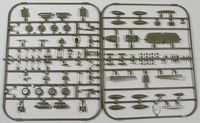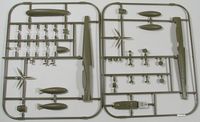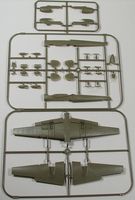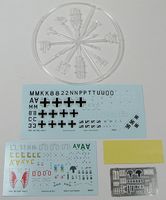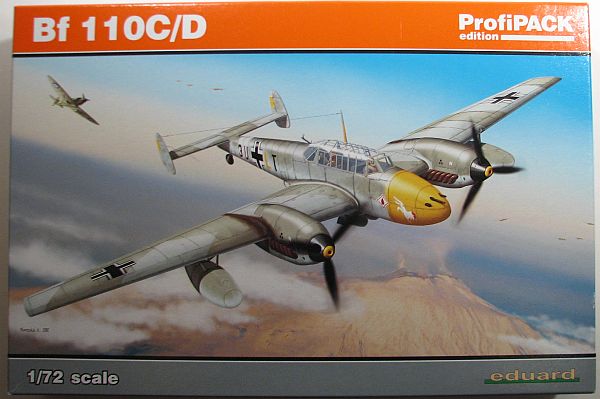
Eduard 1/72 Bf 110C/D
By Matt Bittner
The Kit
This 1/72 Messerschmitt Bf 110C/D from Eduard consists of 127 pieces of tan, injected plastic used (there are more pieces on the sprue, but not used for this boxing); 7 pieces of clear for the canopy pieces; and a photoetch fret with 52 pieces. The molding is top-notch and I can see no problems with the parts at all. The clear is very nicely executed and as thin as injected plastic can be. The photoetch is to the usual Eduard high standards, plus the kit comes with their masks for not only the canopy, but for the wheels, too. Decals are very well done – appear in register – and provide for the following schemes:- W. Nr. 3406, 9.ZG 26, Trapani, Sicily, 1941
- W. Nr. 3148, 2./ZG 76, Norway, Spring 1940
- 2N+AP, 9.ZG 76, flown by Obl. Urban Schlaffer, Bordfunker Gefr. Frantz Observer
- 1./NJG3, North Africa, Summer 1941
- W. Nr. 3602, Stab II./ZG76, flown by Maj. Erich Groth
Construction starts with the cockpit, and there are a lot of pieces. Take your time and study the instructions carefully. You can decide not to use the photoetch as most of the pieces on the photoetch fret are replicated in plastic (except for some things like the throttle quadrant and seat belts, etc.) plus there are decals for the instrument panels. However, to get the "most" from the cockpit and everything supplied, I would definitely use the photoetch.
Once all the cockpit pieces are built-up you then assemble the wings. There are various openings in the lower wing section to drill or cut out, so pay attention to what your scheme requires. Once that's accomplished then you can glue the wing pieces together. At the same time the nacelles are glued together and then glued to the wings.Next is assembling the fuselage, include all internal pieces. Again, there are a lot of pieces that go inside the fuselage halves so pay close attention to the instructions and follow carefully. Once all pieces are glued into one fuselage half then the fuselage halves can be glued together. Now that the fuselage is all together construction continues with the addition of the nose - including its guns - as well as all tail pieces.The next step is masking the clear pieces and adding them to the build. You have the option of either an open or closed pilot's area and the instructions detail what you need to accomplish for each one.
The model is now turned over and items added to the underside. While you'll want to hold off on adding the landing gear until after painting and decaling, you will need to add the underside radiators. Actually the last instruction steps are best left until the end. Those steps include adding the wheels, the tail wheel, the landing gear doors, the DF loop and antenna to the underside, pitot tube and aileron balances, props, exhausts and all ordnance.One big difference between the 'E' release and this one is the use of all the other parts not called for in the 'E' kit directions. Such things as the large, under-fuselage gas tank, or the outer under-wing gas tanks, these are the instructions not only needed for the completion of this 'C/D' release, but will also help if you picked up the separate decals for the 'E', since most of those markings use these extra parts, but the decal instructions don't mention anything about them.
Conclusion
This is an awesome kit in all ways. Eduard has done extreme justice to the Bf 110 with this - and subsequent - releases and you'll be amiss if you don't pick one up. It will take some time due to all the parts, but it shouldn't be a difficult build, given how Eduard kits have gone together in the past.Huge thanks to Eduard for sending this Bf 110C/D to review.

